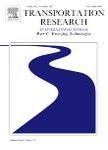版权所有:内蒙古大学图书馆 技术提供:维普资讯• 智图
内蒙古自治区呼和浩特市赛罕区大学西街235号 邮编: 010021

作者机构:Iran Univ Sci & Technol Sch Civil Engn Traff Res Lab Tehran Iran
出 版 物:《TRANSPORTATION RESEARCH PART C-EMERGING TECHNOLOGIES》 (运输研究C部分:新兴技术)
年 卷 期:2019年第98卷
页 面:449-470页
核心收录:
学科分类:08[工学] 0823[工学-交通运输工程]
基 金:Iran University of Science and Technology IUST
主 题:Calibration Estimation of distribution algorithms Copula Dependency structure Static metrics
摘 要:The importance of calibration of microscopic traffic models as the main core of traffic simulation software results from the need for more realistic traffic behaviors. The latent essence of several parameters in such models as well as the uncertainties resulting from the noise in the data, make the process of calibration much more complex. Usually, the calibration process is formulated as an optimization problem. Selecting the appropriate solution algorithm due to nonlinear and non convex nature of the problem is crucial. The importance of the issue is more significant when the matter of calibrating the medium or large-scale simulation model is considered. This is mainly due to the expensive cost that running the simulation models impose. Therefore, applying the current algorithms in which finding the appropriate solutions requires a large number of simulation runs is not deemed suitable. In this paper, an estimation of distribution algorithm based on copula theory has been suggested. In contrast with traditional solution algorithms, in the proposed algorithm complex interaction between parameters of a model has been considered by constructing and sampling from a copula-based probabilistic model. Copulas are functions that describe the dependence structure of a set of random variables and connect multivariate distribution functions to one-dimensional marginal distribution functions. The results indicate that applying an explicit probabilistic model based on copula helps the estimation of distribution algorithm to explore the search space more effectively and efficiently as well as provides the possibility of extracting the knowledge with regard to the structure of the calibration problem through analyzing the probabilistic models that are constructed during the evolution process. Furthermore, this new algorithm has been compared with the genetic algorithm and kernel-based cross-entropy method on synthetic and real trajectory data. The results confirm that the propos